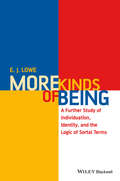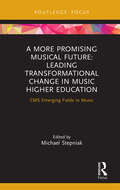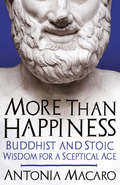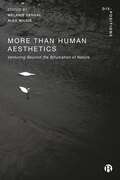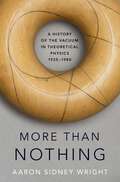- Table View
- List View
More Kinds of Being: A Further Study of Individuation, Identity, and the Logic of Sortal Terms
by E. J. LoweTaking into account significant developments in the metaphysical thinking of E. J. Lowe over the past 20 years, More Kinds of Being:A Further Study of Individuation, Identity, and the Logic of Sortal Terms presents a thorough reworking and expansion of the 1989 edition of Kinds of Being. Brings many of the original ideas and arguments put forth in Kinds of Being thoroughly up to date in light of new developments Features a thorough reworking and expansion of the earlier work, rather than just a new edition Reflects the author's conversion to what he calls 'the four-category ontology,' a metaphysical system that takes its inspiration from Aristotle Provides a unified discussion of individuation and identity that should prove to be essential reading for philosophers working in metaphysics.
More Posthuman Glossary (Theory in the New Humanities)
by Rosi Braidotti, Emily Jones and Goda KlumbytėThe notion of the posthuman continues to both intrigue and confuse, not least because of the huge number of ideas, theories and figures associated with this term. More Posthuman Glossary provides a way in to the dizzying array of posthuman concepts, providing vivid accounts of emerging terms. It is much more than a series of definitions, however, in that it seeks to imagine and predict what new terms might come into being as this exciting field continues to expand. A follow-up volume to the brilliant interventions of Posthuman Glossary (2018), this book extends and elaborates on that work, particularly focusing on concepts of race, indigeneity and new ideas in radical ecology. It also includes new and emerging voices within the new humanities and multiple modes of communicating ideas.This is an indispensible glossary for those who are exploring what the non-human, inhuman and posthuman might mean in the 21st century.
More Posthuman Glossary (Theory in the New Humanities)
The notion of the posthuman continues to both intrigue and confuse, not least because of the huge number of ideas, theories and figures associated with this term. More Posthuman Glossary provides a way in to the dizzying array of posthuman concepts, providing vivid accounts of emerging terms. It is much more than a series of definitions, however, in that it seeks to imagine and predict what new terms might come into being as this exciting field continues to expand. A follow-up volume to the brilliant interventions of Posthuman Glossary (2018), this book extends and elaborates on that work, particularly focusing on concepts of race, indigeneity and new ideas in radical ecology. It also includes new and emerging voices within the new humanities and multiple modes of communicating ideas.This is an indispensible glossary for those who are exploring what the non-human, inhuman and posthuman might mean in the 21st century.
A More Promising Musical Future: CMS Emerging Fields in Music (CMS Emerging Fields in Music)
by Michael StepniakToday’s higher education music faculty and administrators are faced with extraordinary pressure to adapt, innovate, and change. But what change is most critical to pursue – and how can it be brought about effectively? This concise volume brings together four seasoned thought leaders with distinct voices, each providing a complementary glimpse into how music faculty and administrators can help lead changes that truly matter. Making the case for transformations to better align music training in higher education with our culturally diverse society and the actual marketplace facing graduates, the perspectives collected here provide essential change management leadership strategies for music departments in the 21st century. Covering topics such as diversity and inclusion, institutional transformation, and preparing students for contemporary music careers, each chapter includes an outline of specific steps that can be taken individually and collectively towards needed change. Illuminating issues and providing practical suggestions, this book will enable both music faculty and administrators to confidently navigate change together with their communities.
A More Promising Musical Future: CMS Emerging Fields in Music (CMS Emerging Fields in Music)
by Michael StepniakToday’s higher education music faculty and administrators are faced with extraordinary pressure to adapt, innovate, and change. But what change is most critical to pursue – and how can it be brought about effectively? This concise volume brings together four seasoned thought leaders with distinct voices, each providing a complementary glimpse into how music faculty and administrators can help lead changes that truly matter. Making the case for transformations to better align music training in higher education with our culturally diverse society and the actual marketplace facing graduates, the perspectives collected here provide essential change management leadership strategies for music departments in the 21st century. Covering topics such as diversity and inclusion, institutional transformation, and preparing students for contemporary music careers, each chapter includes an outline of specific steps that can be taken individually and collectively towards needed change. Illuminating issues and providing practical suggestions, this book will enable both music faculty and administrators to confidently navigate change together with their communities.
More Sets, Graphs and Numbers: A Salute to Vera Sòs and András Hajnal (Bolyai Society Mathematical Studies #15)
by Ervin Gyori Gyula O. H. Katona László LovászThis volume honours the eminent mathematicians Vera Sos and Andras Hajnal. The book includes survey articles reviewing classical theorems, as well as new, state-of-the-art results. Also presented are cutting edge expository research papers with new theorems and proofs in the area of the classical Hungarian subjects, like extremal combinatorics, colorings, combinatorial number theory, etc. The open problems and the latest results in the papers are sure to inspire further research.
More Than Happiness: Buddhist and Stoic Wisdom for a Sceptical Age
by Antonia Macaro‘This groundbreaking study provides a much-needed philosophical framework for those practising mindfulness as well as a call to recover the pragmatic and therapeutic dimensions of philosophy.’ - Stephen Batchelor, author of After Buddhism and Secular Buddhism Modern readers tend to think of Buddhism as spending time alone meditating, searching for serenity. Stoicism calls to mind repressing our emotions in order to help us soldier on through adversity. But how accurate are our popular understandings of these traditions? And what can we learn from them without either buying in wholeheartedly to their radical ideals or else transmuting them into simple self-improvement regimes that bear little resemblance to their original aims? How can we achieve more than happiness? In More than Happiness, Antonia Macaro delves into both philosophies, focusing on the elements that fit with our sceptical age, and those which have the potential to make the biggest impact on how we live. From accepting that some things are beyond our control, to monitoring our emotions for unhealthy reactions, to shedding attachment to material things, there is much, she argues, that we can take and much that we’d do better to leave behind. In this synthesis of ancient wisdom, Macaro reframes the ‘good life’, and gets us to see the world as it really is and to question the value of the things we desire. The goal is more than happiness: living ethically and placing value on the right things in life.
More-Than-Human Aesthetics: Venturing Beyond the Bifurcation of Nature (Dis-positions: Troubling Methods and Theory in STS)
by Mike Michael Michael Halewood Thomas P. Keating Alexander Damianos Michael L. Thomas Martin Savransky Cecile Malaspina Maximilian Haas Matthew Fuller Andy Goffey Didier Debaise Nicholas GaskillDrawing on the philosophies of Alfred North Whitehead and Félix Guattari, this book develops aesthetics as central to all more-than-human forms of experience, including knowledge practices. Each contribution invites readers on an adventure to explore how this broader view of aesthetics can reshape areas including biomedicine, geological forensics, nuclear waste, race, as well as arts and education. This is an agenda-setting contribution to understanding the significance of aesthetics in science and technology studies, as well social and cultural research more broadly.
More-Than-Human Aesthetics: Venturing Beyond the Bifurcation of Nature (Dis-positions: Troubling Methods and Theory in STS)
by Mike Michael Michael Halewood Thomas P. Keating Alexander Damianos Michael L. Thomas Martin Savransky Cecile Malaspina Maximilian Haas Matthew Fuller Andy Goffey Didier Debaise Nicholas GaskillDrawing on the philosophies of Alfred North Whitehead and Félix Guattari, this book develops aesthetics as central to all more-than-human forms of experience, including knowledge practices. Each contribution invites readers on an adventure to explore how this broader view of aesthetics can reshape areas including biomedicine, geological forensics, nuclear waste, race, as well as arts and education. This is an agenda-setting contribution to understanding the significance of aesthetics in science and technology studies, as well social and cultural research more broadly.
More than Meets the Eye: What Blindness Brings to Art
by Georgina KleegeIn the quarter century following the enactment of the Americans with Disabilities Act, art museums, along with other public institutions, were tasked with making their facilities and collections more accessible to people with disabilities. Although blind and other disabled people have become marginally more visible in recent years, the vast majority of blind Americans remain undereducated and unemployed. In More Than Meets the Eye, Georgina Kleege shows how the scrutiny of one cultural issue-access to arts institutions-in relation to one subset of the disabled population- blind people-can lead us to larger and more general implications. Kleege begins by examining representations of blindness, arguing that traditional theories of blindness often fail to take into account the presence of other senses, or the ability of blind people to draw analogies from non-visual experience to develop concepts about visual phenomena. Following this, the book shifts its focus from the tactile to the verbal, describing Denis Diderot's remarkable range of techniques to describe art works for readers who were not able to view them. Diderot's writing not only provided a model for describing art, Kleege says, but proof that the experience of art is inextricably tied to language and thus not entirely dependent on sight. By intertwining her personal experience with scientific study and historical literary analysis, Kleege challenges traditional conceptions of blindness and overturns the assumption that the ideal art viewer must have perfect vision. More Than Meets the Eye seeks to establish a dialogue between blind people and the philosophers, scientists, and educators that study blindness, in order to create new aesthetic possibilities and a more genuinely inclusive society.
MORE THAN MEETS THE EYE C: What Blindness Brings to Art
by Georgina KleegeIn the quarter century following the enactment of the Americans with Disabilities Act, art museums, along with other public institutions, were tasked with making their facilities and collections more accessible to people with disabilities. Although blind and other disabled people have become marginally more visible in recent years, the vast majority of blind Americans remain undereducated and unemployed. In More Than Meets the Eye, Georgina Kleege shows how the scrutiny of one cultural issue-access to arts institutions-in relation to one subset of the disabled population- blind people-can lead us to larger and more general implications. Kleege begins by examining representations of blindness, arguing that traditional theories of blindness often fail to take into account the presence of other senses, or the ability of blind people to draw analogies from non-visual experience to develop concepts about visual phenomena. Following this, the book shifts its focus from the tactile to the verbal, describing Denis Diderot's remarkable range of techniques to describe art works for readers who were not able to view them. Diderot's writing not only provided a model for describing art, Kleege says, but proof that the experience of art is inextricably tied to language and thus not entirely dependent on sight. By intertwining her personal experience with scientific study and historical literary analysis, Kleege challenges traditional conceptions of blindness and overturns the assumption that the ideal art viewer must have perfect vision. More Than Meets the Eye seeks to establish a dialogue between blind people and the philosophers, scientists, and educators that study blindness, in order to create new aesthetic possibilities and a more genuinely inclusive society.
More Than A Movie: Ethics In Entertainment
by Miguel ValentiIn More Than a Movie, producer and entertainment attorney F. Miguel Valenti presents a compelling argument for the creative community to consider the consequences of its products, from movies to TV to the Internet. Valenti refrains from attacking the industries in which he himself works, but argues for reflection on the part of those who create media. More Than a Movie takes a pioneering first step toward outlining the issues in an insider fashion, and provides the tools to make ethical decisions about creating for the big and small screens. Edited by veteran media writer Les Brown and media consultant Laurie Trotta, More Than a Movie is written to stimulate debate in professional and academic arenas, and for the enjoyment of everyone who loves entertainment. The book contains a foreword by noted author and director Peter Bogdanovich, and commentary from producers Christine Vachon and David Brown. Mediascope, a Studio City, California-based media policy organization, commissioned the book upon discovering that ethical discussions seldom occur in film and television schools, although they are staples for studying law, medicine, business and journalism. Issues range from ethnic and gender stereotyping to excessive and gratuitous violence."It's not about censorship -- it's about having a responsibility for what we do," says author Valenti (no relation to MPAA's Jack Valenti). "The book outlines how we are helping to shape societal values and individual behavior with the artistic choices we make." A team of writers from across the nation offer essays: Neil Hickey, editor, Columbia Journalism Review ; Annette Insdorf, Columbia University; Ted Pease, professor and columnist; Jack Pitman, Variety; Martin Koughan, Emmy Award-winning documentarian. The essays in More Than a Movie are interspersed with stories of actual ethical dilemmas told by noted screenwriters, directors and other practitioners in interviews by Manhattan writer Laura Blum.
More Than A Movie: Ethics In Entertainment
by Miguel ValentiIn More Than a Movie, producer and entertainment attorney F. Miguel Valenti presents a compelling argument for the creative community to consider the consequences of its products, from movies to TV to the Internet. Valenti refrains from attacking the industries in which he himself works, but argues for reflection on the part of those who create media. More Than a Movie takes a pioneering first step toward outlining the issues in an insider fashion, and provides the tools to make ethical decisions about creating for the big and small screens. Edited by veteran media writer Les Brown and media consultant Laurie Trotta, More Than a Movie is written to stimulate debate in professional and academic arenas, and for the enjoyment of everyone who loves entertainment. The book contains a foreword by noted author and director Peter Bogdanovich, and commentary from producers Christine Vachon and David Brown. Mediascope, a Studio City, California-based media policy organization, commissioned the book upon discovering that ethical discussions seldom occur in film and television schools, although they are staples for studying law, medicine, business and journalism. Issues range from ethnic and gender stereotyping to excessive and gratuitous violence."It's not about censorship -- it's about having a responsibility for what we do," says author Valenti (no relation to MPAA's Jack Valenti). "The book outlines how we are helping to shape societal values and individual behavior with the artistic choices we make." A team of writers from across the nation offer essays: Neil Hickey, editor, Columbia Journalism Review ; Annette Insdorf, Columbia University; Ted Pease, professor and columnist; Jack Pitman, Variety; Martin Koughan, Emmy Award-winning documentarian. The essays in More Than a Movie are interspersed with stories of actual ethical dilemmas told by noted screenwriters, directors and other practitioners in interviews by Manhattan writer Laura Blum.
More than Nothing: A History of the Vacuum in Theoretical Physics, 1925-1980
by Aaron Sidney WrightThe vacuum is central to physicists' best theories of subatomic particles, gravitation, and cosmology. Nothingness provides the reference point with which to compare new particle creation and annihilation. Cosmologists use empty universes to study the causal structure of spacetime. Paradoxically, our best physical theories of particles, gravity, and spacetime are theories of nothingness. Stranger still, the physicists' vacuum is a hive of activity. Quantum fluctuations fill empty space with particles, and astronomers measure gravitational waves, the vibrations of empty spacetime itself. More than Nothing uses the history of the vacuum to show how technical concepts in physics are made real through everyday practice. It provides new insight into the development of twentieth-century theoretical physics through sustained analysis of understudied figures including John Wheeler's geometrodynamics and Sidney Coleman's false vacuum. It reveals the surprising influence on physicists from the psychology of impossible objects to drawings of the black hole, and the ways in which the development of the physics of the vacuum became inseparable from the development of larger cultural movements in aesthetics, art, psychology, and fiction. Across decades and across disciplines, More than Nothing shows how physicists over and again chose to study the vacuum for insight into the world around them. Drawing on newly unearthed laboratory notes, private letters, and published material, More than Nothing offers a scoping history of the vacuum as a lens into the development of modern physics.
More than Nothing: A History of the Vacuum in Theoretical Physics, 1925-1980
by Aaron Sidney WrightThe vacuum is central to physicists' best theories of subatomic particles, gravitation, and cosmology. Nothingness provides the reference point with which to compare new particle creation and annihilation. Cosmologists use empty universes to study the causal structure of spacetime. Paradoxically, our best physical theories of particles, gravity, and spacetime are theories of nothingness. Stranger still, the physicists' vacuum is a hive of activity. Quantum fluctuations fill empty space with particles, and astronomers measure gravitational waves, the vibrations of empty spacetime itself. More than Nothing uses the history of the vacuum to show how technical concepts in physics are made real through everyday practice. It provides new insight into the development of twentieth-century theoretical physics through sustained analysis of understudied figures including John Wheeler's geometrodynamics and Sidney Coleman's false vacuum. It reveals the surprising influence on physicists from the psychology of impossible objects to drawings of the black hole, and the ways in which the development of the physics of the vacuum became inseparable from the development of larger cultural movements in aesthetics, art, psychology, and fiction. Across decades and across disciplines, More than Nothing shows how physicists over and again chose to study the vacuum for insight into the world around them. Drawing on newly unearthed laboratory notes, private letters, and published material, More than Nothing offers a scoping history of the vacuum as a lens into the development of modern physics.
More Things in the Heavens: How Infrared Astronomy Is Expanding Our View of the Universe
by Michael Werner Peter EisenhardtA sweeping tour of the infrared universe as seen through the eyes of NASA’s Spitzer Space TelescopeAstronomers have been studying the heavens for thousands of years, but until recently much of the cosmos has been invisible to the human eye. Launched in 2003, the Spitzer Space Telescope has brought the infrared universe into focus as never before. Michael Werner and Peter Eisenhardt are among the scientists who worked for decades to bring this historic mission to life. Here is their inside story of how Spitzer continues to carry out cutting-edge infrared astronomy to help answer fundamental questions that have intrigued humankind since time immemorial: Where did we come from? How did the universe evolve? Are we alone?In this panoramic book, Werner and Eisenhardt take readers on a breathtaking guided tour of the cosmos in the infrared, beginning in our solar system and venturing ever outward toward the distant origins of the expanding universe. They explain how astronomers use the infrared to observe celestial bodies that are too cold or too far away for their light to be seen by the eye, to conduct deep surveys of galaxies as they appeared at the dawn of time, and to peer through dense cosmic clouds that obscure major events in the life cycles of planets, stars, and galaxies.Featuring many of Spitzer’s spectacular images, More Things in the Heavens provides a thrilling look at how infrared astronomy is aiding the search for exoplanets and extraterrestrial life, and transforming our understanding of the history and evolution of our universe.
More Things in the Heavens: How Infrared Astronomy Is Expanding Our View of the Universe
by Michael Werner Peter EisenhardtA sweeping tour of the infrared universe as seen through the eyes of NASA’s Spitzer Space TelescopeAstronomers have been studying the heavens for thousands of years, but until recently much of the cosmos has been invisible to the human eye. Launched in 2003, the Spitzer Space Telescope has brought the infrared universe into focus as never before. Michael Werner and Peter Eisenhardt are among the scientists who worked for decades to bring this historic mission to life. Here is their inside story of how Spitzer continues to carry out cutting-edge infrared astronomy to help answer fundamental questions that have intrigued humankind since time immemorial: Where did we come from? How did the universe evolve? Are we alone?In this panoramic book, Werner and Eisenhardt take readers on a breathtaking guided tour of the cosmos in the infrared, beginning in our solar system and venturing ever outward toward the distant origins of the expanding universe. They explain how astronomers use the infrared to observe celestial bodies that are too cold or too far away for their light to be seen by the eye, to conduct deep surveys of galaxies as they appeared at the dawn of time, and to peer through dense cosmic clouds that obscure major events in the life cycles of planets, stars, and galaxies.Featuring many of Spitzer’s spectacular images, More Things in the Heavens provides a thrilling look at how infrared astronomy is aiding the search for exoplanets and extraterrestrial life, and transforming our understanding of the history and evolution of our universe.
Morenos therapeutische Philosophie: Zu den Grundideen von Psychodrama und Soziometrie
by Ferdinand BuerMoritz Schlick
by BrianMcGuinnessThe idea for this issue arose during a gathering of scholars to com memorate the hundredth anniversary of Moritz Schlick (1882-1936), the philosopher from Germany whose influence gave Austria its most characteristic philosophical voice between the two world wars. He was cut off, tragically, in his prime and while he escaped the exile that awaited most of those who thought like him, he was unable (sadly for philosophy) to continue to steer their thoughts in his own direction and he even lost some of the credit for work already done. Thus it seemed to some of his former pupils and to others more remote from him in the tra dition that a small collection of papers throwing light on his especial con tribution and on the extent to which it is still active or still needed today was a requirement of justice no less than of piety. Tscha Hung, a mem ber of the Vienna Circle and since director of the Institute for Western Philosophy at Peking University, was the chief mover here. Also among the contributors, Ludovico Geymonat (Professor at Milan) was a visitor to the Circle and a friend of Schlick. Henrich Melzer and Joseph Schlichter were Viennese pupils of Schlick's. The former died in the war of 1939-45, the latter is still prominent in the cultural and educational life of Israel.
Moritz Schlick. Erkenntnistheoretische Schriften 1926-1936 (Moritz Schlick. Gesamtausgabe #1.2)
by Johannes Friedl Heiner RutteDer vorliegende, mit Einleitungen und Kommentaren versehene Band enthält Schriften Schlicks aus der Phase des Wiener Kreises, die zu seinen Lebzeiten aus verschiedenen Gründen unveröffentlicht geblieben sind. Zusammen mit den Arbeiten, die in Band I/6 der MSGA vereinigt sind, bieten sie ein umfassendes Bild der Entwicklung von Schlicks (im weiten Sinn verstandener) Erkenntnistheorie in ihrer letzten Periode. Am Beginn des Bandes stehen einige bislang gänzlich unbekannte, Schlicks publiziertes Werk ergänzende Arbeiten. Dem folgt die umfangreiche Abhandlung „Form and Content“, die an die Stelle von Schlicks Hauptwerk, der Allgemeinen Erkenntnislehre, treten sollte. Das letzte Drittel des Bandes bilden vor allem die deutschen Urfassungen von wichtigen Beiträgen zur Protokollsatz- und Physikalismusdebatte im Wiener Kreis; hier wird Schlicks Grundanliegen – die Verteidigung und Ausgestaltung eines auf Erlebnissen basierenden konsequenten Empirismus – besonders deutlich.
Moritz Schlick. Frühe erkenntnistheoretische Schriften (Moritz Schlick. Gesamtausgabe)
Die in diesem Band der Moritz Schlick Gesamtausgabe zusammengestellten Schriften stellen einen Großteil der unveröffentlichten Arbeiten dar, die Moritz Schlick am Anfang seiner philosophischen Laufbahn verfasst hat. Dabei wird vor allem deutlich, wie breit die fachlichen Interessen des jungen Philosophen bereits zu dieser Zeit waren. Die hier edierten Nachlasstexte, die zeitlich zwischen 1908 und 1911 entstanden sind, behandeln nahezu alle wesentlichen Debatten der Universitätsphilosophie der Zeit.
Moritz Schlick. Naturphilosophische Schriften. Manuskripte 1910 - 1936 (Moritz Schlick. Gesamtausgabe)
Die in diesem Band versammelten nachgelassenen Schriften von Moritz Schlick zur Naturphilosophie wurden über einen Zeitraum von annähernd sechs Jahren ediert und kommentiert. Dabei ist eine unverzichtbare Quelle zur Moritz-Schlick-Forschung entstanden, die als Grundlage für weitere Arbeiten dienen kann.
Moritz Schlick. Vorlesungen und Aufzeichnungen zur Logik und Philosophie der Mathematik (Moritz Schlick. Gesamtausgabe)
by Martin Lemke Anne-Sophie NaujoksIn diesem Band sind die nachgelassenen Schriften Moritz Schlicks zur Logik und Philosophie der Mathematik gesammelt, ediert und kommentiert. Keine der zu Lebzeiten veröffentlichten Schriften Schlicks war ausschließlich diesen Themen gewidmet. Man sollte daraus jedoch nicht den Schluss zu ziehen, diese Themen hatten an der Peripherie von Schlicks Interesse gelegen. Überlegungen zur Logik und Mathematik ziehen sich durch Schlicks gesamtes Werk, von der Habilitation, über sein Opus Magnum, die Allgemeine Erkenntnislehre, bis zu seinen letzten stark von Ludwig Wittgenstein geprägten Aufsätzen in den 1930er Jahren. Es ist vielmehr so, dass Schlick Fragen der Logik und Mathematikphilosophie stets im Zusammenhang mit anderen Problemen sah und sie deshalb nie einzeln für sich behandelte. Ausnahmen machte er vor allem für Lehrveranstaltungen und so wundert es nicht, dass fast alle Texte dieses Bandes im Umkreis von solchen entstanden sind.
Moritz Steinschneider. The Hebrew Translations of the Middle Ages and the Jews as Transmitters: Vol I. Preface. General Remarks. Jewish Philosophers (Amsterdam Studies in Jewish Philosophy #16)
by Charles H. Manekin, Y. Tzvi Langermann and Hans Hinrich BiesterfeldtThis book deals with medieval Jewish authors who wrote in Arabic, such as Moses Maimonides, Judah Halevi, and Solomon Ibn Gabirol, as well as the Hebrew translations and commentaries of Judaeo-Arabic philosophy. It brings up to date a part of Moritz Steinschneider’s monumental Die hebraeischen Uebersetzungen des Mittelalters und die Juden als Dolmetscher (The Hebrew Translations of the Middle Ages and the Jews as Transmitters), which was first published in 1893 and remains to this day the authoritative account of the transmission and development of Arabic and Latin, and, by way of those languages, Greek culture to medieval and renaissance Jews. In the work presented here, Steinschneider’s bibliography has been updated, some of his scholarly judgments have been judiciously revised and an exhaustive listing of pertinent Hebrew manuscripts and their whereabouts has been provided. The volume opens with a long essay that describes the origin and genesis of Die Hebraeischen Übersetzungen, and with Steinschneider’s prefaces to the French and German versions of his work. This publication is the first in a projected series that translates, updates and, where necessary, revises parts of Steinschneider’s bio-bibliographical classic. Historians of medieval culture and philosophy, and also scholars of the transmission of classical culture to Muslims, Christians, and Jews, will find this volume indispensable.
Moritz Steinschneider. The Hebrew Translations of the Middle Ages and the Jews as Transmitters: Vol II. General Works. Logic. Christian Philosophers (Amsterdam Studies in Jewish Philosophy #18)
by Charles H. Manekin Hans Hinrich BiesterfeldtThis book surveys Hebrew manuscripts of Aristotelian philosophy and logic. It presents a translation and revision of part of Moritz Steinschneider’s monumental Die Hebraeischen Übersetzungen des Mittelalters und die Juden als Dolmetscher (The Hebrew Translations of the Middle Ages and the Jews as Interpreters). This resource was first published in 1893. It remains to this day the authoritative account of the transmission and development of Arabic and Latin, and, by way of those languages, Greek culture to medieval and renaissance Jews. The editors have updated Steinschneider’s bibliography. They have also judiciously revised some of his scholarly judgments. In addition, the volume provides an exhaustive listing of pertinent Hebrew manuscripts and their whereabouts. The section on logic, including texts hitherto unknown, represents the latest research in the history of medieval logic in Hebrew. This publication is the second in a series of volumes that translates, updates, and, where necessary, revises parts of Steinschneider’s bio-bibliographical classic work on Hebrew manuscripts of philosophical encyclopedias, manuals, and logical writings. Historians of medieval culture and philosophy, and also scholars of the transmission of classical culture to Muslims, Christians, and Jews, will find this volume indispensable.
